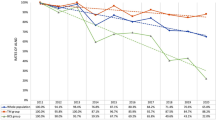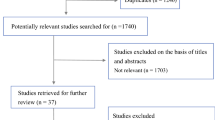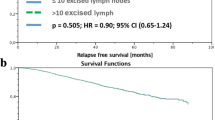Abstract
Background
The omission of axillary lymph node dissection (ALND) in patients with breast cancer who have metastatic sentinel lymph nodes (SLNs) undergoing mastectomy remains controversial. This meta-analysis explored the clinicopathological factors affecting the selection of ALND and the influences of ALND on survival outcomes in patients receiving mastectomy with positive SLNs.
Methods
Eligible studies published prior to 31 December 2022 were selected by searching the Embase, Web of Science and PubMed databases. Pooled analyses were performed using the number of events for clinicopathological parameters and HRs with 95% CIs for survival outcomes including disease-free survival (DFS), overall survival (OS), distant recurrence-free survival (DRFS) and locoregional recurrence-free survival (LRFS).
Results
A total of 10 retrospective studies enrolling only breast cancer patients with limited SLN metastases (no more than 3 positive SLNs or micrometastatic SLNs) undergoing mastectomy were included. Performing ALND in mastectomy patients who had limited SLN metastases was significantly correlated with invasive ductal carcinomas, larger tumors, lymphovascular invasion, higher tumor grade, macrometastatic SLNs, more positive SLNs, extranodal extension, positive surgical margins, negative ER, administration of adjuvant chemotherapy and nonwhite race (P < 0.05). However, performing ALND did not result in significantly longer OS, DFS, LRFS or DRFS (P > 0.05) in these patients.
Conclusion
The present meta-analysis indicated that ALND may be safely avoided in patients with breast cancer who had limited SLN metastases undergoing mastectomy. Further well-designed randomized clinical trials are warranted to validate our results.



Similar content being viewed by others
References
Cardoso F, Kyriakides S, Ohno S et al (2019) Early breast cancer: ESMO clinical practice guidelines for diagnosis, treatment and follow-up. Ann Oncol 30:1674
Rockson SG (2018) Lymphedema after breast cancer treatment. N Engl J Med 379:1937–1944
Del Bianco P, Zavagno G, Burelli P et al (2008) Morbidity comparison of sentinel lymph node biopsy versus conventional axillary lymph node dissection for breast cancer patients: results of the sentinella-GIVOM Italian randomised clinical trial. Eur J Surg Oncol 34:508–513
Reyna C, Johnston ME, Morris MC et al (2021) National trends for axillary lymph node dissection and survival outcomes for clinical T3/T4 node-negative breast cancer patients undergoing mastectomy with positive lymph nodes. Breast Cancer Res Treat 189:155–166
Giuliano AE, Hunt KK, Ballman KV et al (2011) Axillary dissection vs no axillary dissection in women with invasive breast cancer and sentinel node metastasis: a randomized clinical trial. JAMA 305:569–575
Galimberti V, Cole BF, Zurrida S et al (2013) Axillary dissection versus no axillary dissection in patients with sentinel-node micrometastases (IBCSG 23–01): a phase 3 randomised controlled trial. Lancet Oncol 14:297–305
Donker M, van Tienhoven G, Straver ME et al (2014) Radiotherapy or surgery of the axilla after a positive sentinel node in breast cancer (EORTC 10981–22023 AMAROS): a randomised, multicentre, open-label, phase 3 non-inferiority trial. Lancet Oncol 15:1303–1310
Savolt A, Peley G, Polgar C et al (2017) Eight year follow up result of the OTOASOR trial: the optimal treatment of the axilla—surgery or radiotherapy after positive sentinel lymph node biopsy in early-stage breast cancer: a randomized, single centre, phase III, non-inferiority trial. Eur J Surg Oncol 43:672–679
Fu Y, Chung D, Cao MA et al (2014) Is axillary lymph node dissection necessary after sentinel lymph node biopsy in patients with mastectomy and pathological N1 breast cancer? Ann Surg Oncol 21:4109–4123
Joo JH, Kim SS, Son BH et al (2019) Axillary lymph node dissection does not improve post-mastectomy overall or disease-free survival among breast cancer patients with 1–3 positive nodes. Cancer Res Treat 51:1011–1021
Picado O, Khazeni K, Allen C et al (2018) Extent of regional lymph node surgery and impact on outcomes in patients with early-stage breast cancer and limited axillary disease undergoing mastectomy. Breast Cancer Res Treat 171:461–469
Sun J, Mathias BJ, Laronga C et al (2021) Impact of axillary dissection among patients with sentinel node-positive breast cancer undergoing mastectomy. J Natl Compr Canc Netw 19:40–47
Page MJ, McKenzie JE, Bossuyt PM et al (2021) The PRISMA 2020 statement: an updated guideline for reporting systematic reviews. BMJ 372:n71
Stroup DF, Berlin JA, Morton SC et al (2000) Meta-analysis of observational studies in epidemiology: a proposal for reporting. meta-analysis of observational studies in epidemiology (moose) group. JAMA 283:2008–2012
Stang A (2010) Critical evaluation of the Newcastle-Ottawa scale for the assessment of the quality of nonrandomized studies in meta-analyses. Eur J Epidemiol 25:603–605
Jiang D, Gao Z, Cai Z et al (2015) Clinicopathological and prognostic significance of FOXP3+ tumor infiltrating lymphocytes in patients with breast cancer: a meta-analysis. BMC Cancer 15:727
Davey MG, Ryan EJ, Davey MS et al (2021) Clinicopathological and prognostic significance of programmed cell death ligand 1 expression in patients diagnosed with breast cancer: meta-analysis. Br J Surg 108:622–631
Parmar MK, Torri V, Stewart L (1998) Extracting summary statistics to perform meta-analyses of the published literature for survival endpoints. Stat Med 17:2815–2834
Tierney JF, Stewart LA, Ghersi D et al (2007) Practical methods for incorporating summary time-to-event data into meta-analysis. Trials 8:16
Higgins JP, Thompson SG, Deeks JJ et al (2003) Measuring inconsistency in meta-analyses. BMJ 327:557–560
Higgins JP, Thompson SG (2002) Quantifying heterogeneity in a meta-analysis. Stat Med 21:1539–1558
Mamtani A, Patil S, Stempel M et al (2017) Axillary micrometastases and isolated tumor cells are not an indication for post-mastectomy radiotherapy in stage 1 and 2 breast cancer. Ann Surg Oncol 24:2182–2188
Wu SP, Tam M, Shaikh F et al (2018) Post–mastectomy radiation therapy in breast cancer patients with nodal micrometastases. Ann Surg Oncol 25:2620–2631
Kim BK, Park BW, Hur MH et al (2020) Omission of axillary lymph node dissection in patients who underwent total mastectomy with 1 or 2 metastatic lymph nodes. Ann Surg Treat Res 98:283–290
Lim SZ, Kusumawidjaja G, Mohd Ishak HM et al (2021) Outcomes of stage I and II breast cancer with nodal micrometastases treated with mastectomy without axillary therapy. Breast Cancer Res Treat 189:837–843
Gao W, Lu S, Zeng Y et al (2022) Axilla lymph node dissection can be safely omitted in patients with 1–2 positive sentinel nodes receiving mastectomy: a large multi-institutional study and a systemic meta-analysis. Breast Cancer Res Treat 196:129–141
Wang Z, Wu LC, Chen JQ (2011) Sentinel lymph node biopsy compared with axillary lymph node dissection in early breast cancer: a meta-analysis. Breast Cancer Res Treat 129:675–689
Glechner A, Wockel A, Gartlehner G et al (2013) Sentinel lymph node dissection only versus complete axillary lymph node dissection in early invasive breast cancer: a systematic review and meta-analysis. Eur J Cancer 49:812–825
Li CZ, Zhang P, Li RW et al (2015) Axillary lymph node dissection versus sentinel lymph node biopsy alone for early breast cancer with sentinel node metastasis: a meta-analysis. Eur J Surg Oncol 41:958–966
Peristeri DV, Harissis HV (2021) Axillary lymph node dissection vs sentinel biopsy only among women with early-stage breast cancer and sentinel node metastasis: a systematic review and meta-analysis. Breast J 27:158–164
Krag DN, Anderson SJ, Julian TB et al (2010) Sentinel-lymph-node resection compared with conventional axillary-lymph-node dissection in clinically node-negative patients with breast cancer: overall survival findings from the NSABP B-32 randomised phase 3 trial. Lancet Oncol 11:927–933
Riedel F, Heil J, Feisst M et al (2020) Analyzing non-sentinel axillary metastases in patients with T3–T4 cN0 early breast cancer and tumor-involved sentinel lymph nodes undergoing breast-conserving therapy or mastectomy. Breast Cancer Res Treat 184:627–636
Dingemans SA, de Rooij PD, van der Vuurst de Vries RM et al (2016) Validation of six nomograms for predicting non-sentinel lymph node metastases in a Dutch breast cancer population. Ann Surg Oncol 23:477–481
Kuru B, Sullu Y, Yuruker S et al (2016) Factors predicting non-sentinel lymph node metastasis in T1–2 invasive breast cancer with 1–2 axillary sentinel lymph node metastases: presentation of Ondokuz Mayis scoring system. J BUON 21:1129–1136
Zheng J, Cai S, Song H et al (2018) Positive non-sentinel axillary lymph nodes in breast cancer with 1–2 sentinel lymph node metastases. Medicine 97:e13015
van la Parra RF, Peer PG, Ernst MF et al (2011) Meta-analysis of predictive factors for non-sentinel lymph node metastases in breast cancer patients with a positive SLN. Eur J Surg Oncol 37:290–299
Wang XY, Wang JT, Guo T et al (2019) Risk factors and a predictive nomogram for non-sentinel lymph node metastases in Chinese breast cancer patients with one or two sentinel lymph node macrometastases and mastectomy. Curr Oncol 26:e210–e215
Takei H, Kurosumi M, Yoshida T et al (2010) Axillary lymph node dissection can be avoided in women with breast cancer with intraoperative, false-negative sentinel lymph node biopsies. Breast Cancer 17:9–16
Wong J, Yong WS, Thike AA et al (2015) False negative rate for intraoperative sentinel lymph node frozen section in patients with breast cancer: a retrospective analysis of patients in a single Asian institution. J Clin Pathol 68:536–540
Qiao G, Cong Y, Zou H et al (2016) False-negative frozen section of sentinel lymph node biopsy in a Chinese population with breast cancer. Anticancer Res 36:1331–1337
Si J, Guo R, Pan H et al (2022) Axillary lymph node dissection can be omitted in breast cancer patients with mastectomy and false-negative frozen section in sentinel lymph node biopsy. Front Oncol 12:869864
Luo H, Yang OO, He JL et al (2022) Impact of post-mastectomy radiation therapy for sentinel lymph node micrometastases in early-stage breast cancer patients. Med Sci Monit 28:e933275
Almahariq MF, Quinn TJ, Siddiqui ZA et al (2020) Post-mastectomy radiotherapy is associated with improved overall survival in T3N0 patients who do not receive chemotherapy. Radiother Oncol 145:229–237
Collaborative EBCT, G (2018) Long-term outcomes for neoadjuvant versus adjuvant chemotherapy in early breast cancer: meta-analysis of individual patient data from ten randomised trials. Lancet Oncol 19:27–39
Giuliano M, Schettini F, Rognoni C et al (2019) Endocrine treatment versus chemotherapy in postmenopausal women with hormone receptor-positive, HER2-negative, metastatic breast cancer: a systematic review and network meta-analysis. Lancet Oncol 20:1360–1369
Park HS, Chae BJ, Song BJ et al (2014) Effect of axillary lymph node dissection after sentinel lymph node biopsy on overall survival in patients with T1 or T2 node-positive breast cancer: report from the Korean breast cancer society. Ann Surg Oncol 21:1231–1236
Tinterri C, Gentile D, Gatzemeier W et al (2022) Preservation of axillary lymph nodes compared with complete dissection in T1–2 breast cancer patients presenting one or two metastatic sentinel lymph nodes: the sinodar-one multicenter randomized clinical trial. Ann Surg Oncol 29:5732–5744
Author information
Authors and Affiliations
Corresponding author
Ethics declarations
Conflict of interest
The authors declare no conflicts of interest.
Additional information
Publisher's Note
Springer Nature remains neutral with regard to jurisdictional claims in published maps and institutional affiliations.
Supplementary Information
Below is the link to the electronic supplementary material.
Rights and permissions
Springer Nature or its licensor (e.g. a society or other partner) holds exclusive rights to this article under a publishing agreement with the author(s) or other rightsholder(s); author self-archiving of the accepted manuscript version of this article is solely governed by the terms of such publishing agreement and applicable law.
About this article
Cite this article
Chen, F., Li, X., Lin, X. et al. Can Axillary Lymph Node Dissection be Omitted in Breast Cancer Patients with Metastatic Sentinel Lymph Nodes Undergoing Mastectomy? A Systematic Review and Meta-Analysis of Real-World Evidence. World J Surg 47, 2446–2456 (2023). https://doi.org/10.1007/s00268-023-07072-8
Accepted:
Published:
Issue Date:
DOI: https://doi.org/10.1007/s00268-023-07072-8




